
- Source: studio international
- Author: Veronica Simpson
- Date: February 14, 2022
- Format: Digital
Cauleen Smith – interview: ‘I don’t know if optimism is needed so much as vigilance’
The artist on what it was like to have her lockdown Instagram posts on Covid shown on the vast screens at Piccadilly Circus, having her film about New Orleans in the aftermath of Hurricane Katrina shown in Edinburgh, and her longing to go off and work quietly for a while
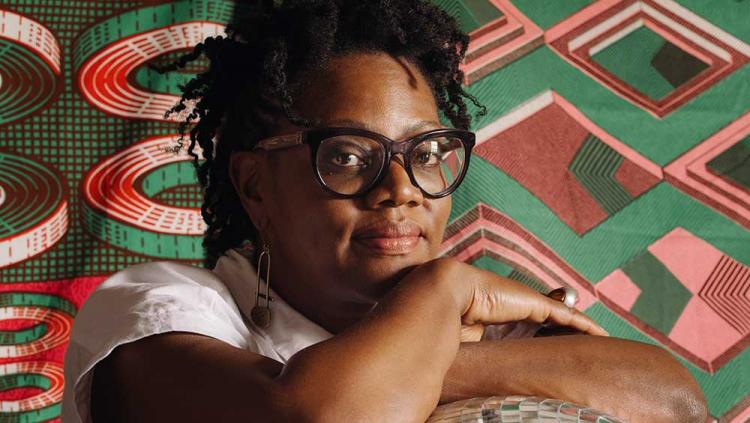
Cauleen Smith. Photo courtesy the artist.
Cauleen Smith (b1967, Riverside, California) has had a busy couple of years. For all that she has spent far too many of the last 24 months shut in her studio in Los Angeles, she has been active, teaching, making work, releasing work, talking about the work, participating in group shows, and almost all of it online. However, it was in person that I was able to see one of her most powerful works, H-E-L-L-O (2014), currently on show at Edinburgh’s Collective art space, at one of the highest points of the city centre’s surrounding volcanic outcrops, on top of Calton Hill. Here, Collective, an artist-run charity, has lovingly restored and repurposed a quirky collection of 18th- and 19th-century structures built so that Edinburgh’s astronomical society could get closer to the stars.
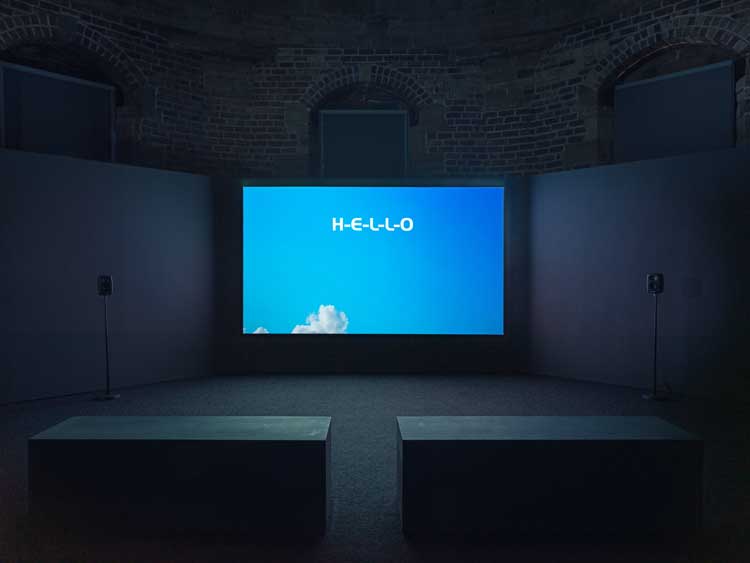
Cauleen Smith. H-E-L-L-O, 2014. Installation view, Collective art space, Edinburgh, 2022.
Smith’s film is screened in the round tower constructed in 1895 for what was then the state-of-the-art, Buckingham telescope. By way of a contrast to this lofty setting, the film H-E-L-L-O is located in the swampy marshlands of New Orleans, an area that is mostly below sea level and vulnerable to storms and extreme weather events. In fact, it is the devastating impact and aftermath of Hurricane Katrina that the film bears witness to. Katrina was a Category 5 Atlantic hurricane, which caused more than 1,800 deaths and more than US$125bn in damage, with the biggest impact being on New Orleans. But Smith’s film really homes in on the damage that has been done to the long established African American community through the city’s eagerness to embrace regeneration. Using the five-note musical motif from Steven Spielberg’s Close Encounters of the Third Kind, Smith signals a desire for connection across boundaries and borders, real and imagined.
Smith’s 1998 debut film, Drylongso, focused on societal threats towards black men, and African American identity is a common thread, as is feminism, especially her Sojourner (2018) film, highlighting the emergence of utopian feminist collectives during the last century, and using the writings of Shaker visionary Rebecca Cox Jackson, abolitionist Sojourner Truth and pioneering jazz harpist and spiritual visionary Alice Coltrane.
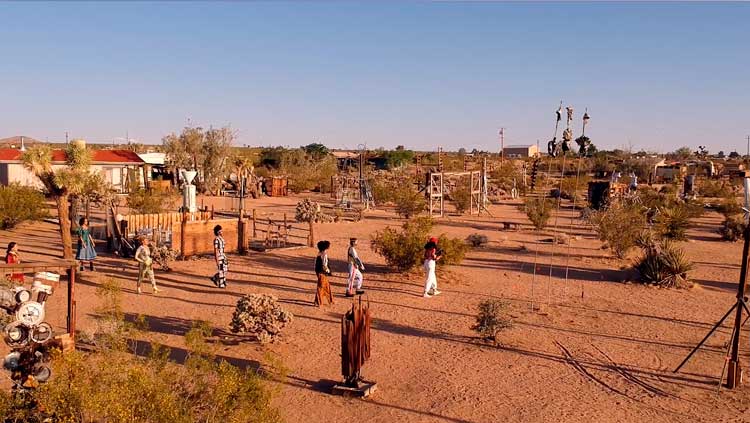
Cauleen Smith. Sojourner, 2018. Film still, courtesy of the artist.
Music and literature are also central to her work. A big fan of the written word, in 2015-16 she created the Human_3.0 Reading List and, in 2019, the BLCK FMNNST Loaner Library 1989-2019. In 2020, her Instagram Covid Manifesto writings were shown every night for a month on one of Europe’s largest screens, in London’s Piccadilly Circus as part of a series of online artist occupancies curated by Circa.art.
Smith received her BA in creative arts from San Francisco State University and an MFA from the University of California, Los Angeles, School of Theater, Film and Television. She has appeared in many group shows and has had solo shows at Los Angeles County Museum of Art (2020); The Whitney Museum of American Art, New York (2020); The Frye Museum, Seattle, Washington (2019); the Institute for Contemporary Art at VCU, Richmond, Virginia (2019); the Institute of Contemporary Art, Philadelphia, Pennsylvania (2018); the Art Institute of Chicago (2017); the Museum of Contemporary Art, Chicago (2012); and The Kitchen, New York (2011), among others.
Veronica Simpson: Tell me about H-E-L-L-O, which is currently on show in Edinburgh. I know it was inspired by the toll that Hurricane Katrina took on the community of New Orleans.
Cauleen Smith: This film was made in 2014, nine years after the hurricane, and therefore well into the recovery of the city. I had been there about three years after Katrina, in 2008, when the city was still broken, and I made a video that time. This was my first time returning. My first few days there, I was doing research for the project I was supposed to do, but I was constantly disoriented because the city – in its being rebuilt – was changed in ways that made it really unrecognisable, sometimes. And all the people I formed relationships with and worked with the first time that I made a film there could no longer even afford to live in the city because of the rate of gentrification.
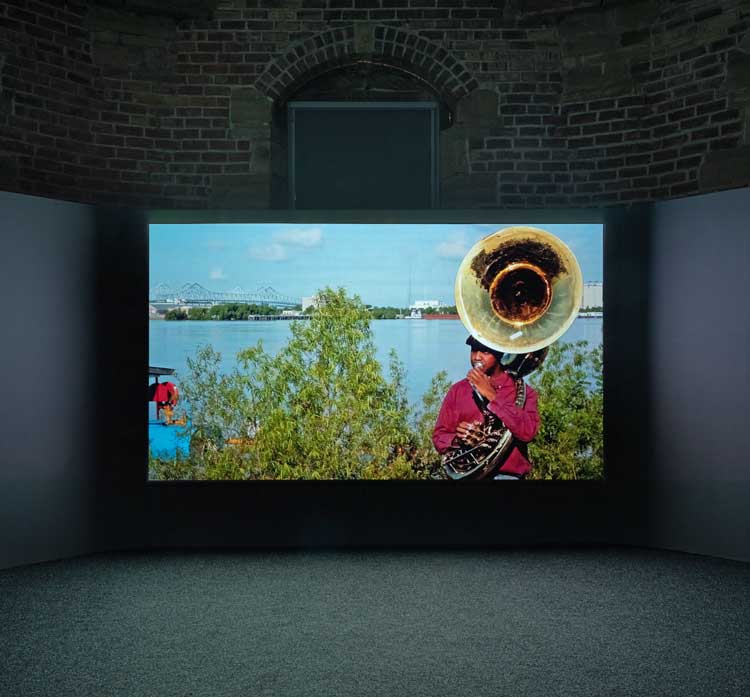
Cauleen Smith. H-E-L-L-O, 2014. Installation view, Collective art space, Edinburgh, 2022.
So, even though people who were managing to live in the city were feeling really optimistic – like, it’s so great to have cafes and a sense of normalcy and jobs – as a visitor, I was feeling really alienated because all the people I knew and had bonded with weren’t able to live in their own city any more, and these were people who had been there for generations. I was really disturbed by that. I was doing a lot of research into the process of recovery and talking to people who lived there and finding myself, I guess, conflicted about this desire for a recovery and normalcy versus what was being lost for the city.
New Orleans is a very crucial North American and world city. There is no other place like it because of the way it was colonised by the French and the Spanish. And it’s the end of the Caribbean, in some sense: New Orleans, geographically, would be the last stop. It has that same feeling of the Caribbean in cultures, but that is all hinging on the people who live there. And they are being pushed out. That’s how I arrived at making this piece, which, initially, was actually a commission to make a live procession in New Orleans, but that seemed like a bad idea given that I’m not from there and the people in New Orleans who do processions are experts in it. This is the idea I arrived at by talking to people there, of moving through the city and speaking to what can no longer be seen. And that leads to the bass clef and the subterranean, and what lies underneath.
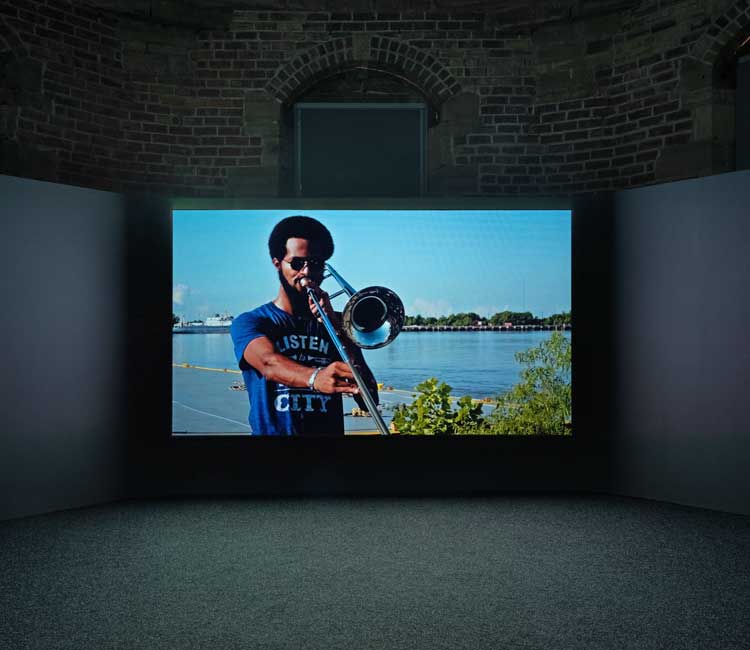
Cauleen Smith. H-E-L-L-O, 2014. Installation view, Collective art space, Edinburgh, 2022.
VS: Your camera circles around individual musicians playing wonderful bass, mostly brass instruments – also cello – but who are all standing or sitting on the same spot during the film. How did you arrive at these sites and that choreography?
CS: I used a map that was taken from the book Unfathomable City: A New Orleans Atlas, co-written by Rebecca Snedeker and Rebecca Solnit. Rebecca Snedeker is one of my friends who was still living there and sensitive to this ambivalence about recovery – on the one hand, she’s so happy to see her city re-emerging and yet she is so disturbed by the kind of erasure of an African American presence. She shared the book with me, and a particular map … which was tracing the bass clef through the underground histories of New Orleans. It really resonated with me as a way to visit the city and see the things that were hard to see.
It was a very low-budget operation, so we were just in the flatbed of a truck, I’m siting someone in the middle of the street and we’re just driving around them until we get something suitable.
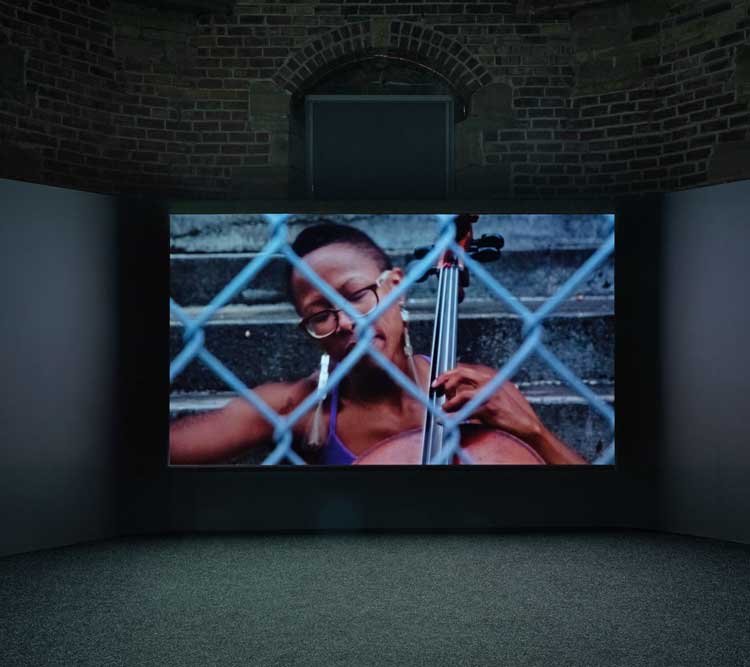
Cauleen Smith. H-E-L-L-O, 2014. Installation view, Collective art space, Edinburgh, 2022.
VS: I am struck by the sound of these wonderful brass instruments – especially the sousaphone, which doesn’t get an outing very often.
CS: In New Orleans, the sousaphone is the star, it’s a crucial instrument and it has this deep historical significance. It’s so wonderful to celebrate that instrument.
VS: The use of that bass pitch throughout the film is experienced as a physical presence, especially in that lovely round observation tower in Edinburgh. The sound really resonates in the belly, doesn’t it? It’s a low, grounding, growling frequency.
CS: Yes. That was part of my research – the sound. What makes the bass frequency so fascinating, and the higher frequencies, too, is that when you’re hearing that growling, that purring, what you’re actually hearing is a sine wave dipping below our ability to hear. We’re just feeling the vibration and we’re not actually hearing (the note) any more. A lot of animals communicate this way – lions and elephants; even a cat, what you’re hearing is a frequency that you can only hear half of. That’s amazing.
VS: That’s also resonant with what you’re saying about regeneration, about what you don’t see in a city that’s being regenerated because of who is being removed and what you lose when that happens. That’s really profound. How did you pick the musicians?
CS: I hired a legendary musician called Carl LeBlanc (an avant garde jazz guitarist and banjo player), whom I was so excited to meet because this is like a musician that played with Sun Ra, and I hired him to sort of be my music fixer and procure all these bass clef musicians. They all know each other. It’s much faster for him to make these calls and he was so thorough. He didn’t just focus on his community of improvising musicians, he found that wonderful musician from the symphony, who played the contrabassoon. He looked everywhere. He even found a pipe organ, but filming it was problematic.
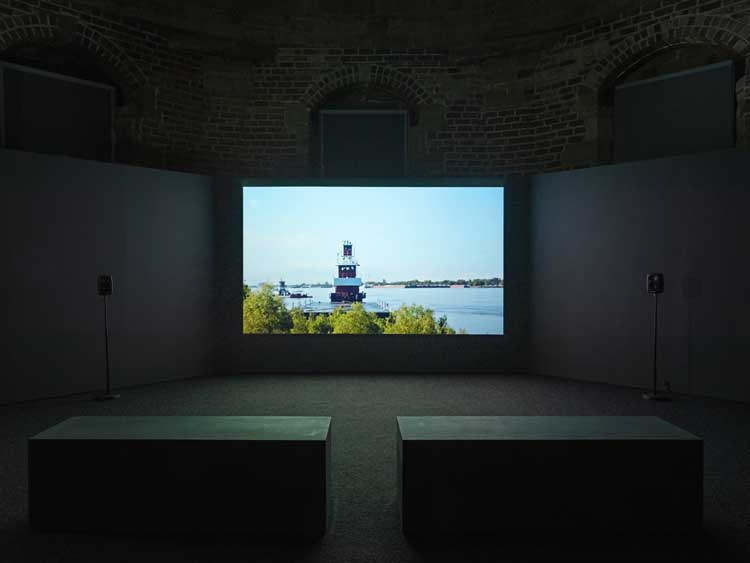
Cauleen Smith. H-E-L-L-O, 2014. Installation view, Collective art space, Edinburgh, 2022.
VS: The presence of the water through most of the film is obviously so haunting when you know what happened there – that sense of the menace in the water. It looks so calm that day you were filming, so tranquil, the sun is shining, it’s like nothing bad could happen here. But something really bad did happen.
CS: Yeah, that’s the Mississippi river that’s been giving us problems for ever, and the reason it’s been giving us problems is because we disregard its power. So, it’s an incredibly powerful aquatic entity -that’s kind of how I think of that river.
VS: I love the story of how your film landed in Edinburgh: how Emmie McLuskey, who is a young artist and producer at Collective, was given this opportunity by Collective to curate her own show and she picked this film. There’s something about it being on that incredible spot, on top of Calton Hill, which has been owned by the city “for the common good” since Edinburgh town council acquired it in 1724. And because of that legal status they can’t let a developer do anything on it. It is pretty much the best location in the whole of Edinburgh, and I love the fact that an artist-run collective gets to occupy that space and share it with everyone. I thought this might have appealed to you, because you have talked in interviews about your commitment to public space, how those freedoms in public spaces and opportunities to share work have been eroded during the pandemic. So, there are nice synergies in setting the work on that site.
CS: I was really intrigued with her invitation. She had really thought about how well the film would work there. It was just a matter of showing me the space (virtually) to convince me. And how elegant it is just to have this one film and not need anything else because of the dome and that site. I am so eager to go there. Even with these films I’ve already made, I think of them being sited. I’m also very curious about the relationship of one coastal city to another.
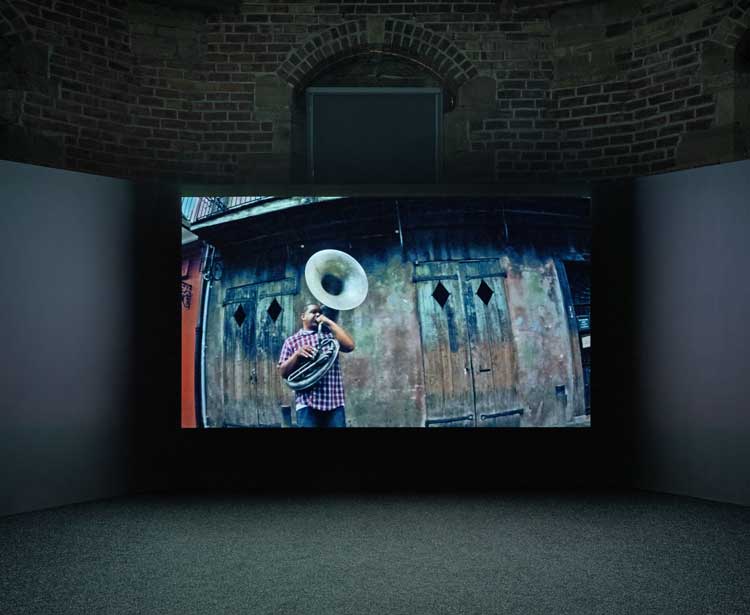
Cauleen Smith. H-E-L-L-O, 2014. Installation view, Collective art space, Edinburgh, 2022.
VS: Have your frustrations about not being able to share work in person shifted now? Is 2022 looking more optimistic?
CS: It seems so. It’s difficult to tell if institutions are just wishing for things to be business as usual or if things really are going to be possible. I feel like things could be shut down again at any moment if we don’t behave and keep our transmission rates low. Institutions are shipping work around the world again. In a way, we’re almost back to how we were before, which I’m not sure is something we should return to. So, I feel ambivalent. I spent most of my time here in Los Angeles really wishing I could explore the city I live in. When I first moved here four years ago, I was so busy, I was flying out of town every week. But then, in the first nine months of the pandemic, even parks were closed. I thought a lot about what it would mean to dig deeper into Los Angeles as a site and I’m still thinking about that, but I love that the work is travelling. New Orleans is a bowl, it’s literally below sea level, and now (the film) is perched on a site at the very top of a city. I love these kinds of equations.
VS: And it’s in a place designed for looking at the stars.
CS: That’s wonderful, and they are both old cities, so I think there’s an interesting way of connecting them.
VS: You talked very eloquently in an interview with ArtNews about the importance of people experiencing art and culture in real life, and the protests of the last two years being a crucial part of that. You said: “We can’t have a revolution without the grounding of art and culture.” Do you feel anything has shifted in the subjects and the people who are being given a voice in our cultural institutions currently?
CS: We’ll see. This has happened before, maybe on a regional level. Where there’s a social rupture, sometimes it gets people’s attention long enough that they make some overtures towards change. Like in 1992, there was the LA rebellion, the riots in response to the acquittal of police officers in the Rodney King trial. And that was a huge rupture in LA and LA became a better city because of that, but it didn’t stick. And I don’t have any reason to think that, even on this global level, it will be different. We might see some improvements, but we’ll have to watch and see how many people are sustaining them. We just don’t know. I don’t know if optimism is needed so much as vigilance. And art is so crucial and it’s so important for people to be able to encounter it, and experience how it … fires your imagination or disrupts your sense of self, it’s so important.
One of the things in the US that Covid has produced that’s been disturbing is where, in the interests of safety, you enter art institutions and there’s a lot of controlling of behaviour. In one site, there were numbers on the floor to tell you what direction you could walk. This is overprogramming of people’s movements. I worry about that stuff.
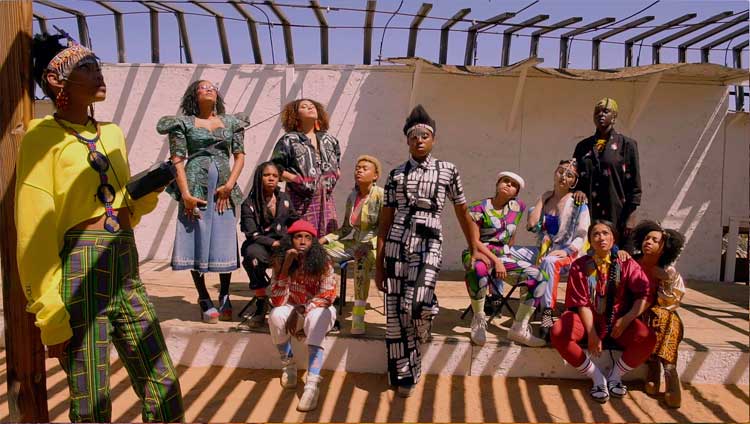
Cauleen Smith. Sojourner, 2018. Film still, courtesy of the artist.
VS: Yet often your work is focused on positivity – like your Sojourner film (2018), which tracks the existence of alternative, utopian communities through these young female “Sojourners”. There’s a great clip with you talking about the film, from San Francisco Museum of Modern Art.
CS: I’m not sure I think of it so much as optimism. These things did happen. These collectives existed, they were successful. In the face of capitalistic logics where we are constantly told that something isn’t possible because it’s not in alignment with the way capitalism works, there’s evidence all around us that these things can work. I don’t think I’m hoping or wishing, I’m just looking at what people have done in a hopeful way … People are terrified to imagine what would happen if we stopped extracting from one another or exploiting one another or if we had systems that didn’t depend on that. But people are imagining it and doing it all the time.
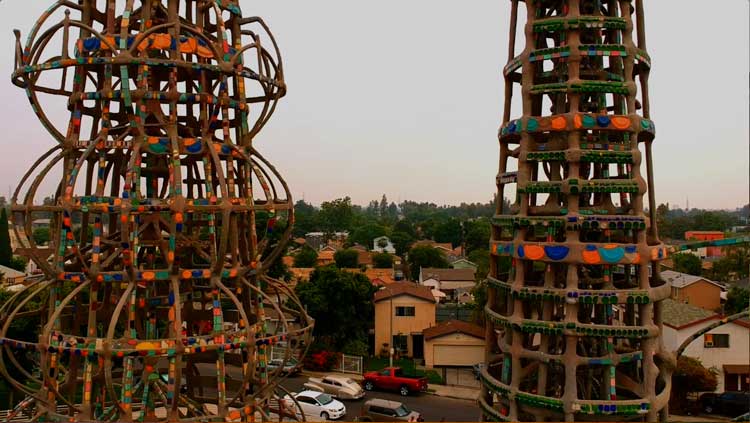
Cauleen Smith. Sojourner, 2018. Film still, courtesy of the artist.
VS: You were talking to ArtNews about creating a space or an experience that cultivates people’s intellectual and physical wellbeing. How hard is it as a film-maker to create a space that is intellectually and emotionally enriching when there is so much to be critical and angry about.
CS: I depend on learning about these people and their lives as evidence of what’s possible … I am always looking for people who are finding a way to, I guess, even remind themselves of their own humanity, and that way it helps me do the same, and it also helps me see it in others. I don’t want to use the word compassion or empathy. It helps me to hopefully recognise the possibility that everyone at any point could be someone who could be engaged. I try to make my work that way so that it is porous for anyone, as opposed to exclusive.
VS: That strikes me as very true of your Covid Manifesto, in which you are expressing your own but also universal realities in lockdown. How did that work come about?
CS: I started out with really silly snarky laments that I would write on Post-its and photograph and put on Instagram as a way to generate conversation with friends all over the place. That was when we were in the big lockdown. I was a little bit shocked at how people responded to these complaints. Now, when I look back on it, I don’t know if people remember that there were riots and people were targeting banks to burn down. But that happened. And I was commenting on these things, and how quickly people forget. Then an arts organisation in London (Circa.art) said it wanted to put them on one of the largest video screens in Europe in Piccadilly Circus. And as a film-maker I can’t resist a big screen, I can’t say no. I found a way to translate them into these table-top still lives and that also became very well received. It was shown in November 2020: every day for a month, I posted a two-minute video on the Piccadilly Circus screen. The thing that’s sad about it is that I swore that that the work would be irrelevant by now. I was sure that it would be like this relic or time capsule, but it’s not going to be.
VS: Tell me what you’ve got lined up for 2022.
CS: Edinburgh is happening, and I’m really hoping to visit. There’s going to be a group show in London this summer, at the Hayward, The Black Fantastic, curated by Ekow Eshun. I have a piece that’s travelling over, from a collection in Los Angeles County Museum of Art, which I am really excited about. It’s a really big video installation. In the fall, I’m hoping to have a show here in my home town of LA. I’m really hoping to make some new work. I’ve had a stretch of three years of making work, installing it, then having it tour. I’m hoping to put that to bed and have some time to go into my studio every day and maybe have people forget me for a little while so I can make some new things and share them a little bit later.
• Cauleen Smith: H-E-L-L-O is at Collective, Edinburgh, until 1 May 2022.
A video installation by Smith will be on show as part of In the Black Fantastic at the Hayward Gallery, London, from 28 June-18 September 2022.

